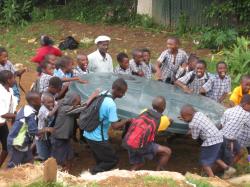Clean Water in Schools
Water is life. Clean water improves people’s health. International Action helps make clean water possible.
The Problem: Water Shortage in Haitian Schools

The children of Haiti bear the brunt of poverty and misery. Over one year after the earthquake, many children roam the streets without proper homes, schools, or clean water. One child out of every eight dies before the age of five of preventable diseases, such as diarrhea, typhoid, and malaria – the highest mortality rate among children in the Western Hemisphere. To make matters worse, most schools in Haiti have no access to clean water. Lack of hygiene and sanitation has become a major problem for Haitian students. They fall ill regularly and are unable to attend classes or fail to perform well
Our Solution: Keeping Kids in School

Through many interviews with school teachers and directors, we’ve learned that in Port-au-Prince diarrhea afflicts far more children than any other waterborne disease. A child with diarrhea is often kept home from school, and when diarrhea is not prevalent, attendance rates quickly improve. Clean water is one of the simplest remedies for chronic diarrhea, which is why we started the Clean Water in Schools project.
International Action installs water tanks in schools throughout metropolitan Port-au-Prince and the surrounding provinces. We currently provide clean water to 92 schools in the slum area of Cité Soleil – Haiti’s most impoverished and densely populated commune. Among the schools we protect are École Mixte Frère en Jesus, École Mixte des Vaillants, École Mixte Evangelique de Secours, and Collège Mixte le Samaritain en Action. In total, 13,000 students in Cité Soleil receive clean water from our many Campaign for Clean Water projects.
International Action has also created a handwashing and sanitation guide that teaches children – ages 6 through 12 – the importance of handwashing. The guides have been distributed to the teachers at schools sponsored by our partner, American Institutes for Research.
